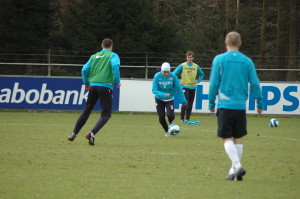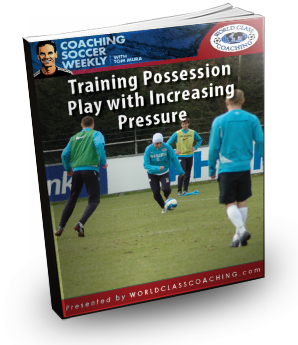Podcast: Play in new window | Download
Subscribe: Apple Podcasts | RSS
Thanks!
We continue to receive a lot of positive feedback on the podcast.
A ‘Five Star’ review on iTunes from ‘Flying Dave’ says, “I’m thoroughly enjoying this podcast. I find it hard to talk soccer coaching with other coaches. My wife is tired of me bouncing ideas off of her. I’m super pleased to hear about coaching from other coaches. thanks!”
Thanks for the review and rating Dave!
Another ‘Five Star’ review is from Arima 19 says, “Have been coaching for 20 years and this is a great vehicle for creating ideas and different ways of presenting your training sessions. When setting up your training sessions, you are likely by yourself and these podcasts act like a second coach to help customize your coaching ideas. Easy to understand with good back up diagrams. Well Done!”
Thanks Arima!
While I really appreciate the kind words and positive feedback, this week I’m looking for something different. Please let me know if there’s something you don’t like about the show. Maybe something you’d suggest we change. Everything is fair game except the host, sorry, you’re stuck with me. 🙂
We want this coaching resource to be the best it possibly can be and if there’s something we can change to improve your experience, we want to try to do it.
You can leave your suggestions in the comments section below or email them to me at tommura@worldclasscoaching.com.
In This Episode
I take a look at possession play. My guess is that the most commonly used games by soccer coaches are possession games. This is especially true today with our love for all things possession related.
The challenge is to set up the game to applies enough pressure but not so much that the players don’t experience any success.
If it’s too easy then it doesn’t transfer to match situations. If it’s to hard then the players get frustrated.
The game below strikes a great balance between pressure and success because the pressure increases as the players become successful. This ‘self-regulating’ type of game ensures that the pressure is always challenging without being overwhelming.
Transitional Possession Game
Coaches often use possession games that have two teams of six or more players competing to keep the ball away from the other team. If the teams are having trouble keeping possession then they will add a neutral player or two in order to give the team with the ball a numerical advantage that will make it easier for them to keep the ball.
Usually this will be a non-directional game played in a large area. The number defenders involved make it difficult for players to see the shape of the game and connect passes successfully to move the ball away from pressure.
The following possession game is my favorite game of this type for any age group because it solves many of the issues that the ordinary possession games have.
Set-Up
Use a space the size of two penalty areas. This is an easy way to make the size of the area relative to the age of the players. Divided the space in half and put eight players on each team. Fewer is fine but keep the size of the area relative to the number of players and their ability level as well as their age.
One team is on each side of the area. The coach has a supply of balls at the halfway line.
How the Game Works
One team begins with the ball. The other team sends over two defenders. Five passes equals one point.
Have the players count the passes and points out loud so everyone is aware of the score. I have the players do this because ‘I’m coaching not counting’. I want to be free to give tips and make corrections as the game is being played without worrying about what the score is. Another defender enters the attacking area after each point is scored.
The defenders try to win the ball and move it back to their side of the field. If they do, the other team sends over two defenders. The teams organize who becomes the defenders. When the ball goes out of play the coach plays a new ball into whichever team should have possession.
Benefits
- Starts with less pressure
- Progressively gets more difficult as players get better at possession
- Defenders have to win the ball not just kick it out
- They have to keep it until they can get it to their side of the field
- Includes an element of transition
- New defenders need to move quickly to pressure
- The team has to communicate about who will defend
- Great opportunity to teach players to reshape the Right – Left – Split shape
Coaching Points
- Body shape
- Open to the largest part of the field and teammates
- First touch away from pressure
- Use the back foot to open up
- Support the player on the ball
- Make sure there is a Right – Left – Split
- Spread the field to create space
- Switch the ball away from pressure
You can control the pressure on the attackers by starting with fewer defenders. You could even start with NO defenders for the first five passes. With very young players you can have the defenders crawl like crabs or hop on one foot to defend.
With older or more experienced players you can allow them to leave one defender in the other team’s area. This will make transition more difficult and allow for immediate pressure.
Variation for Restart of Play
Another way to restart play when the balls goes out of play is to number the players. When the ball goes out the coach calls a number and those players race to the coach for a ball.
Focus on Defending
This is a great game to teaching pressing. Keep the same set-up and game play but change the scoring system. Give five points if the defending team wins the ball before five passes are completed. They receive three points if they win the ball after 10 passes. The defending team receives one point any time after that.
This creates the motivation for the defenders to work hard. It also provides an opportunity to teach pressure, cover and balance.
I feel that it’s important keep the game flowing and only coach within the game without stopping the action.
You can also give coaching points between rounds of play. Play until a team reaches a set number of points then give the players a break and discuss what can be done better. The play another round and focus on those coaching points during the flow of play.
As you can see this is a possession game that you can shape to fit the age and ability level of your players. Since the pressure is controlled by the amount of success they have the players will gain confidence quickly and the pressure will increase as they improve.
You can also control the focus of the game by deciding how points will be earned. Give points for passes when you want to work on possession and give points for winning the ball when you want to have the players focus on pressing the ball. Once you’ve used this game a few times with each scoring system you will see the players improving on both sides of the ball.
Finally, this is a great conditioning game that will improve the player’s fitness while they are also working on their technique and small group tactics.
Printable Show Notes
The show notes for each episode are accessed through the WCC Training Center.
They are FREE but you will need at least a Free Membership to the Training Center in order to view and print them.
Click on the image of the notes and if you’re already logged in to the Training Center you’ll be taken to the Podcast page. If you’re not logged in your be taken to a login page where you’ll also be able to login or register if you are not already a Member.
Remember!
Make sure you subscribe to Coaching Soccer Weekly through iTunes, or your podcast provider of choice, to be sure you never miss an episode.
We would appreciate it if you would leave us a 5 star rating and/or a written review on iTunes to help spread the word about the show and ensure that we can continue to bring you top notch guests in the future.
In the Next Episode
In next week’s episode I’ll share a complete training session inspired by the quick passing and combination play of Barcelona and Bayern Munich.






decent
thanks
Thanks. A very nice game to educate how to work with the defence.
I’ve seen an used this training session on various occasions. Used it to teach offensive principles of play and other times defensive principles. “Not counting” and focusing on coaching was excellent point. Thanks for teaching me something new!
Since you would like us to comment on what we would like to change, here goes. Is it possible to put up some video of these exercises instead of just static diagrams? Even if it is video of your youth teams doing these drills, it would give a good idea of what it should look like, as well as (I’m sure) some examples of what can go wrong and how you adjust the exercise to make it work.
I always pick up some new information from your podcasts, even on things I have been doing for years.
Thanks.
Thanks for the feedback Dave. I’m going to try recording some sessions and see how it goes. The challenge is that this will add a lot of time to the process of putting episodes together. But I’ll give it a try since so many coaches have requested it.
Thank you for educating us and developing the game
I have used this on many occassions. Have also used it to improve the counter attacking of my team as well as to teach pressing.
Love your blog and podcast Coach. I have used this with my U10 and U12 players. They love it! Now coaching U14 for the first time and its a staple . Any suggestions for a good technical warmup prior to this one?
Thanks Roger. I would usually do diamond passing and 4v1 / 4v2 before this to emphasize the need for support on the right/left and split as well as body shape and quality passes.
I’ve gone away from this a bit because we’ve been doing a lot of position specific possession (ie 2v2+3 and 4v4+3). I like how it shows the players similar shapes to the ones they’ll see in the games.
Thanks for the reply. Would you happen to have a link you would be willing to share to some possession drills that are more position specific that you find easy to get going and more importantly that kids “buy” into ? That is always the “holy grail” of coaching for me it seems
Episode 6 has some good variations on the 5 v 2 that have worked well for me.
https://coachingsoccerweekly.com/006-better-ways-to-play-5-v-2/
4 v 4 + 3 is a little more complicated but I’ve played it with my U10’s and they were able to understand the basics.
Here’s a link to a video describing it: https://youtu.be/SrkZQ97ABCk